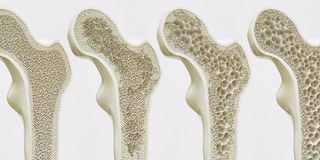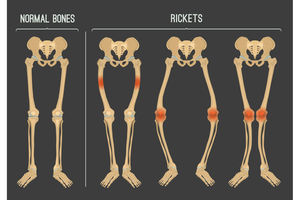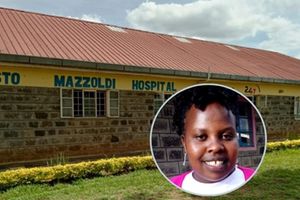Osteoporosis: Symptoms, causes and treatment

What you need to know:
- Osteoporosis refers to a condition in which one's bones lose their density and consequently, their strength.
- Early signs of osteoporosis include losing the strength of one's grip, and receding gums.
- Women are more likely to suffer from osteoporosis than men.
Osteoporosis is a medical condition in which bones become weak and brittle. When an individual has osteoporosis, they are at a greater risk for sudden and unexpected bone fractures.
According to the Centre for Disease Control (CDC), the onset of osteoporosis will mean that you will have less bone mass and strength.
“People who come down with osteoporosis are more likely to break bones. This is most often in the hip, forearm, wrist, and spine,” the CDC says. “While bones can get broken as a result of a fall or an accident, osteoporosis weakens them to an extent where the bones break at from alarmingly easy causes. These can include coughing or bumping into something.”
In addition, osteoporosis can cause the bones in the spine to break and begin to collapse. According to the CDC, if this happens, the height of the patient might be affected. The patient may no longer be able to stand straight and may appear to be shorter than they usually are.
“Where the patient has suffered broken hips, they may no longer be able to live independently, and may have a higher mortality rate,” the CDC states.
Osteoporosis is not easy to determine unless the patient receives medical screening and testing. The CDC states that the majority of people who get this condition do not know that they have osteoporosis until after they have broken a bone.
Who is at risk?
Women are at an increased risk of getting osteoporosis over men. According to the CDC, this is because women have lower peak bone mass and generally smaller bones than men.
“Osteoporosis affects women at a higher ratio of 1 in 5 for women aged 50 and over in contrast to a ration of 1 in 20 for men in the same age bracket,” the CDC says. In the majority of cases, women develop osteoporosis one to two years before menopause.
A family history of osteoporosis is also a risk factor. If one of your parents struggles with osteoporosis, there is an elevated risk that you may get this condition as well.
According to the United States’ biomedical research agency National Institute of Health (NIH), low levels of hormones can increase your risk of developing osteoporosis.
“These include low oestrogen in women after menopause, low oestrogen due to delayed or missing periods caused by hormonal disorders and aggressive physical activities in premenopausal women, and low levels of testosterone in men,” cites the NIH.
There are also medical conditions that might set you on a collision path with osteoporosis. These include diabetes, kidney failure, hyperthyroidism, rheumatoid arthritis, dementia, cystic fibrosis, sickle cell disease, inflammatory bowel disease, and a history of breast cancer.
Symptoms
Osteoporosis rarely exhibits symptoms. However, by knowing the risk factors associated with it, you will be better placed to spot signs and symptoms that might point toward developing this condition.
These symptoms include frequent, easy bone fractures, an apparent loss of height, a change in your general posture (for example, you might start bending forward or start stooping), frequent, persistent pain in your lower back, and shortness of breath. According to the CDC, this shortness of breath is caused by compressed disks that make your lungs smaller.
At the onset of this condition, you might notice that the grip of your hand has become very weak and that your gums are receding. This will be the result of your jaws losing bone mass.
Treatment and management
The management and treatment for osteoporosis mainly involves treating and preventing broken bones, and taking medicine to strengthen bones.
Here, the target is to slow or stop bone loss altogether, and prevent possible fractures as much as possible.
According to the NIH, the treatment regime that your doctor will recommend will usually involve medication, a proper, well-balanced diet (nutrition), lifestyle changes, exercises, and prevention of fractures.
If you have osteoporosis or think you might be at risk, there are some steps that you can take to manage this condition or keep it at bay.
According to the CDC, these include taking prescribed and medically approved medications to strengthen your bones, stopping smoking and avoiding alcohol, doing guided exercises to improve your weight abilities, and eating a healthy diet that contains the right amounts of calcium and vitamin D.
Calcium and vitamin D will be critical in helping your bones reach their peak bone mass. “If you do not teat enough calcium, your body will take it from your bones. This may lead to bone loss, bone weakening and bone thinning which trigger osteoporosis,” the NIH cautions.
Per the NIH, products you can consume to boost your calcium intake include low-fat dairy products, turnip greens, broccoli, sardines and salmon, soy milk, orange juice, cereals, and breads.
You should take these together with foods that give you vitamin D that aids in the absorption of calcium from the intestine.
“You get vitamin D from exposure to sunlight, and from certain foods including fatty fish, fish oils, egg yolks, liver, milk and cereals,” states the NIH.
People aged between 18 and 50 years need 1,000 milligrams of calcium a day. This daily amount increases to 1,200 milligrams when women turn 50 and men turn 70 years old.
If you are taking calcium supplements, you should be careful not to trigger kidney stones. Your total calcium intake from supplements and diet combined should not be more than 2,000 milligrams daily if you are aged 50 years and above.
Eat properly. For instance, excessive dieting or poor protein intake will increase your risk of bone loss and trigger the development of osteoporosis.
Avoid taking alcohol. According to the NIH, regularly drinking more than two alcoholic drinks per day will increase your risk of developing osteoporosis.
It is also recommended that you engage in regular weight exercises help to build up your bone mass. These exercises include walking, jogging, climbing stairs, and dancing. They are exercises that you do on your feet so that your weight is supported by your bones.
You may combine weight-bearing exercises with strength exercises to firm up your muscles and bones in your arms and upper spine, and balance exercises to stabilise yourself from falls.




